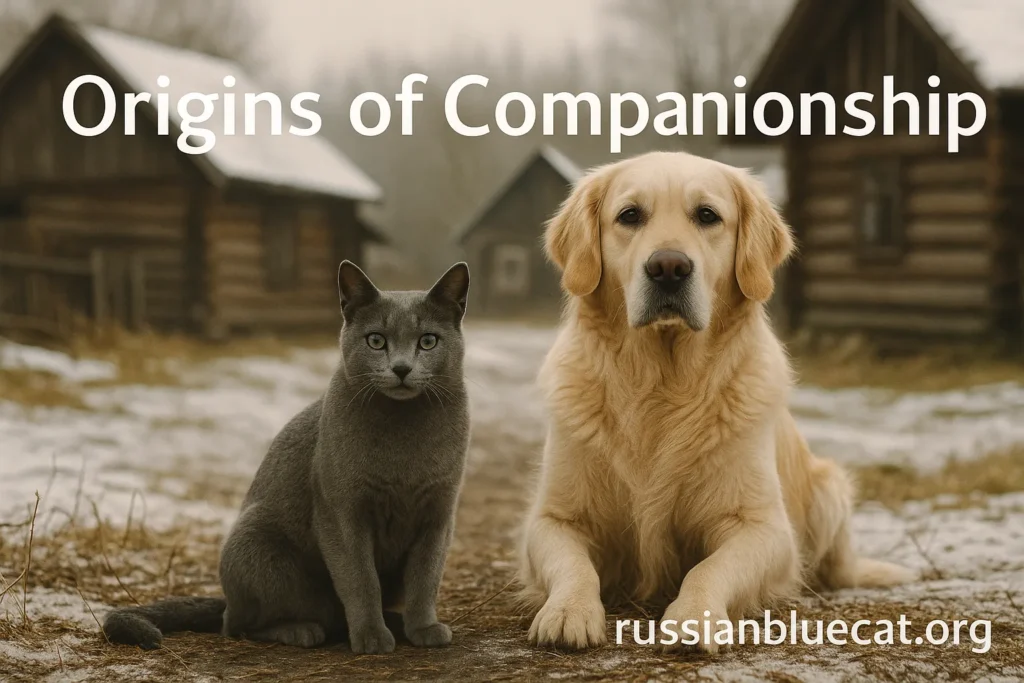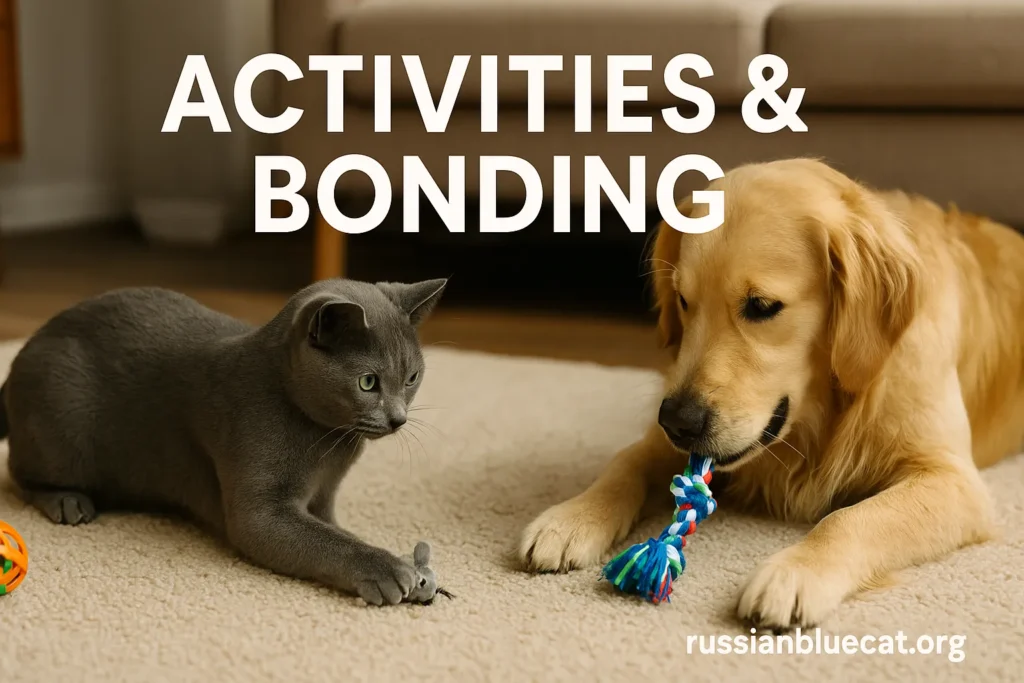Russian Blue Cats and Dogs: The Complete 2025 Guide

Introduction: Why Russian Blue Cats and Dogs Make an Unlikely but Perfect Pair
To most pet owners, the idea of cats and dogs coexisting peacefully is a fantasy. However, when it comes to Russian Blue Cats and Dogs, the tale ends well. Russian Blue cats possess intelligence, loyalty, and calm temperament, while certain breeds of dogs offer companionship, playfulness, and security. If introduced carefully, these two animals can complement one another, converting your house into a harmonious, joyful place.
In this guide, you will discover it all from breed characteristics and introductions to feeding, training, grooming, and even traveling.
The Elegant Heritage of Russian Blue Cats
Origin and History

Russian Blue is a breed whose history is shrouded in mystery. They were thought to have originated in the port city of Arkhangelsk in northern Russia, and sailors valued them for their stunning looks and tranquil temperament. They became much-loved shipmates on journeys and soon swept Europe. Check our detailed guide on Russian Blue Cat History.
Physical Features That Are Out of the Ordinary
Russian Blues are distinguished by their glistening silver-blue coats and compelling emerald-green eyes. Their double coat is soft to the touch, like plush velvet, and serves to defend them in colder environments. They shed less than other breeds, which makes them more suitable for allergy-sensitive families.
Personality that Complements Dogs
Even though they are shy at first, Russian Blues bond strongly with their families and are loyal to them. Russian Blues love routine and hate turmoil, but, given time, many accept and even relish the presence of dogs as long as the dogs are friendly.
Choosing the Right Dogs for Russian Blue Cats
Why Compatibility Matters

Not all dog breeds are a good match for living with cats. There are some dogs with a high prey drive that can be hazardous to smaller pets. Russian Blues, as sensitive and intelligent as they are, require canine friends who are calm, respectful, and less likely to chase.
Dog Breeds that Work Best with Russian Blue Cats
- Golden Retrievers: Their patience and loving personality make them automatic peacemakers.
- Labrador Retrievers: High-energy but friendly, they fit well into multi-pet homes.
- Cavalier King Charles Spaniels: Friendly lap dogs who like being around people rather than fighting.
- Poodles: Both Miniature and Standard are intelligent, easy to train, and considerate.
- Basset Hounds: Low-key and easy-going — a good match for Russian Blues.
Breeds to Watch Out For
Terriers, Huskies, and Greyhounds, for instance, can be more prey-prone. Training will be beneficial, but close supervision is essential.
Making Your Home Ready for Russian Blue Cats and Dogs
Creating Safe Spaces for Cats
Cats require vertical space. Cat trees, wall shelves, and raised perches allow your Russian Blue the opportunity to find safety when the dog becomes too rambunctious. This alleviates stress and eliminates conflict.
Separate Feeding Stations
Dogs adore cat food due to its high protein content, but it’s not good for them. Similarly, cats cannot survive on dog food. Provide higher feeding areas for cats where they can dine in solitude, while dogs feed on the floor.
Toys and Enrichment for Both
Interactive feeders, puzzle toys, and cat scratching posts, along with chew toys and balls for dogs, keep both of them stimulated. Equal attention avoids jealousy.
The First Encounter Between Russian Blue Cats and Dogs

Step 1: Scent Exchange
Begin by exchanging bedding or rubbing a cloth on both pets, then positioning it close to the other. This helps them get used to the scent without face-to-face coercion.
Step 2: Controlled Encounters
Take your dog on a leash and leave the cat unrestricted, allowing it to come over at its own pace. Never push closeness; patience is the key.
Step 3: Positive Reinforcement
Reward relaxed behavior. Compliment your dog for remaining still and reward your Russian Blue with treats for exploring without fear.
Short sessions over days or weeks create trust, the basis for extended peace.
Day-to-Day Care for Russian Blue Dogs and Cats
Grooming Habits
- Russian Blue Cats: Brushing once a week keeps their thick coat silky.
- Dogs: Grooming depends on the breed, but brushing and bathing regularly keeps the coat healthy.
Exercise and Playtime
- Russian Blues like feather wands, laser pointers, and puzzle toys.
- Dogs require outdoor exercise, fetch toys, and training exercises.
Mixing both guarantees harmony and less built-up energy that can trigger mayhem.
Feeding Russian Blue Cats and Dogs

Nutritional Needs of Russian Blue Cats
Russian Blue Cat love high-protein foods loaded with chicken, fish, and good kibble. Being overweight is a threat, and portion control is imperative.
Nutritional Needs of Dogs
Dogs require a combination of proteins, fats, carbs, and fiber based on energy needs and breed size. Don’t feed them cat food it’s too rich in protein and fat for dogs.
Feeding Separately
To avoid fights and overeating, always feed cats and dogs in separate rooms or at separate times.
For reliable nutrition information, the American Kennel Club offers great guidance.
Training Russian Blue Cats and Dogs Together
Educating Dogs to Respect Cats
“Leave it” and “stay” commands are a must. Train dogs to forego chasing or barking at the cat.
Clicker Training Cats
Yes, cats can be trained too! Russian Blues are smart and pick up clicker training using rewards. Check our detailed guide on Russian Blue Cat Training.
Establishing Trust Through Scheduling
Both species feel secure with regular schedules, less stress, and more cooperation.
Behavioral Insights
Russian Blue Cats
- Shy but loving when they trust humans.
- Smart problem-solvers.
- Enjoy quiet and stability.
Dogs
- Playful and loyal, but need firm rules.
- More social, loving to stay busy.
Russian Blue Cats and Dogs together balance one another the cat’s tranquil nature balances the dog’s exuberance.
Typical Challenges in Multi-Pet Homes
Prey Drive in Dogs
Some dogs will instinctively chase cats. Training and close supervision are necessary.
Territorial Cats
Cats will first defend their territories. Safe areas allow them to acclimate slowly.
Feeding Conflicts
Different feeding times ensure both pets get the correct nutrients without tension.
Health and Veterinary Care
- Plan vet appointments for both breeds.
- Vaccinations, parasite control, and dental care are essential.
- Russian Blues require weight monitoring; dogs might require joint health supplements.
Fun Activities for Russian Blue Dogs and Cats

- Fetch and Chase: Dogs bring back toys; cats chase feathers.
- Agility Courses: Cats prefer tunnels; dogs prefer obstacles.
- Joint Training: Train both pets new tricks simultaneously solidifies the bond.
Grooming Harmony
Cats and dogs can gradually learn to groom each other over time, a heartwarming sign of trust. It means they regard each other as family. Check our detailed guide on Russian Blue Cat Grooming.
Travel and Outdoor Adventures
Russian Blue Cats, if trained well, can be taught to walk on a leash with dogs. Start indoors, then move on to short walks outside. With time, even pets can enjoy family treks.
FAQs About Russian Blue Cats and Dogs
Conclusion
Living with Russian Blue Cats and Dogs is possible, rewarding, and often heartwarming. With patience, structured introductions, and ongoing care, these two species can grow into inseparable companions.
By understanding their unique needs, respecting boundaries, and fostering trust, you’ll create a home where cats and dogs not only coexist but thrive side by side.






